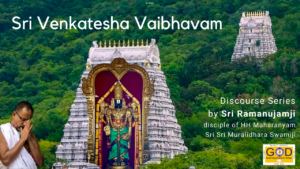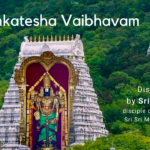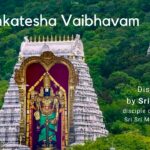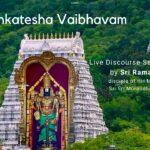Relishing the Venkatesha Vaibhavam Series
Celebrating the arrival of Sri Aishwarya Srinivasa Perumal in Houston, Sri Ramanujamji, disciple of Sri Swamiji, is taking us on a journey to His divine abode by reminiscing the greatness of Lord Srinivasa and Venkatachalam, based on the divine work – ‘Divyadesa Vaibhavam’ by Paranur Mahatma Sri Sri Krishnapremi Maharaj. This is an ongoing series filled with immense rasa.
This series is available to listen on our Namadwaar E-Satsang YouTube channel at this playlist:https://https://youtube.com/playlist?list=PLf2GTja1Pr3P0Yr_AsYTOi9KnzUBlI1sE

We shall now enjoy a few divine droplets from the fifteenth episode of this series.
The Story of Venkatadri and more..

In this series, we have been seeing in detail the story of the seven hills.
Sesha Bhagavan descended and became the Divine Padhukas for Bhagavan. Hence, the first hill is known as Seshadri.
Next hill is Vrishabadri. Rishis, knowing the divinity in those hills, came and resided there. An asura called Vrishabhasura started tormenting the rishis. Bhagavan himself came as a warrior and vanquished the asura. Due to the divinity in those hills, the asura, at the time of his death, prayed to Bhagavan for His Darshan. Bhagavan blessed him with His darshan and also promised that the hill will henceforth be known as Vrishabadri. Thus, Vrishabadri came to be.
The third hill is Narayanadri. There is a mode of worship called Vaikanasa. This method of worship was revealed by Bhagavan to Vikanasa rishi. Narayana muni belonged to the lineage of Vikanasa rishi and when he came and prayed to Bhagavan, Bhagavan instructed him to worship using the Vaikanasa mode of worship.
The fourth hill is Anjanadri, the birthplace of our dear Hanumanji (which we enjoyed in the last episode).
The next in the series is Venkatadri.
Once, there was a man named Madhava. He was a learned scholar and a virtuous person. Just like Ajamila, he once went to the forest, saw a beautiful young girl and became attracted to her. He pursued her relentlessly and forcefully without her consent. The young girl ran back to her tribe crying and they, in turn, thrashed him. When his own people came to know of his despicable act, they too disowned him. As a result, he had no means to earn a livelihood. He begged for his food and sometimes even resorted to stealing and other sinful acts. As a result, he accumulated a lot of sins.
Soon, as a result of all his sins, he got afflicted by a disease. His physical form became so terrible that people despised coming near him. He was also in extreme pain. In such a state, by chance (which we devotees call as Krishna Krupa), he happened to step into the seven hills. As soon as he stepped inside, he was engulfed in flames. As the rishis saw this sight in surprise, Madhava came out of the flames as a purified person. Not only were his sins burnt, but his tendency to sin as well. All this happened because of the divinity of the hill Venkatadri.
“Ven” means the sum total of all our sins. Kata means burning. Venkata means the burning of all our sins. When one comes close to the hill, then all sins are burnt.
In Sri Madhurageetham, “Govinda undan namame azhagu..” Sri Swamiji sings to Bhagavan that His Name is so beautiful and adds that this name resonates in the hills. Everyone there chants the Govinda Nama that even those who may be just listening, initially, also start chanting.
And, in another Sri Madhurageetham, Sri Swamiji sings, “Namam solla solla, paavam parandidum,… ” As we chant his name, all our sins fly away. This is the greatness of Venkatadri.
Traveling further, the next hill is Garudadri. When Garuda Bhagavan was carrying Amrita for his mother, he came and rested in this hill and a drop fell down. So, the hill is known as Garudadri. And, the final hill – Simhadri is associated with Narasimha Bhagavan.
Thus, the seven hills of Tirumala came to be.
Enjoy the full discourse here: https://www.youtube.com/watch?v=bs8iurCarNM&list=PLf2GTja1Pr3P0Yr_AsYTOi9KnzUBlI1sE



